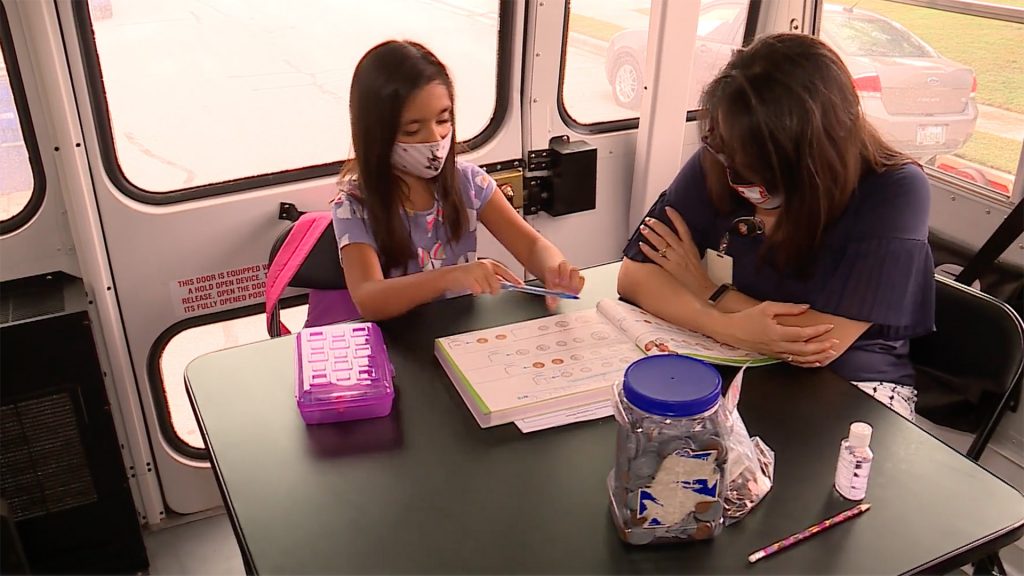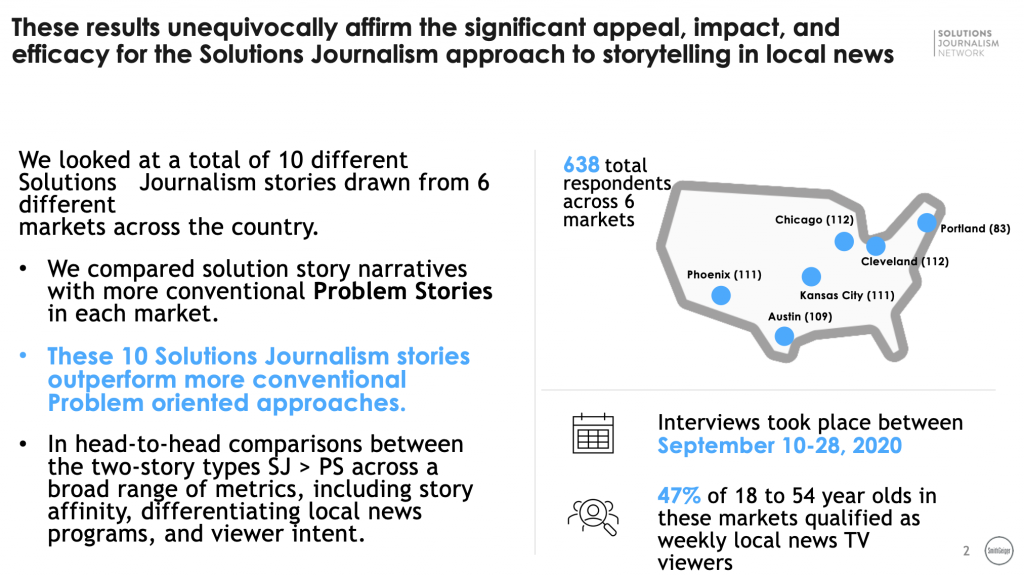
“We kind of knew — but we didn’t.” That wry bit of wisdom from WBBM-TV news director Jeff Harris aptly describes one key role that market research can play: applying data to news decisions that were based on experience, aspiration, and sometimes just gut instinct. In this case, Harris is talking about new research on “solutions journalism” — a set of techniques for rigorous reporting on responses to community problems.
The nonprofit Solutions Journalism Network (SJN) started training local TV newsrooms around the country in its methodology early last year. This fall, following one of its own precepts — namely, the importance of measuring outcomes — SJN commissioned a study from the highly respected research, strategy and design firm SmithGeiger. The results, published just last month, not only affirm the benefits to viewers and stations of embracing a solutions journalism approach, but they may point the way to a significant next stage in the evolution of local TV news.

SmithGeiger put together a sample of 638 local news viewers from six markets with stations that practice solutions journalism — Chicago, Cleveland, Austin, Phoenix, Kansas City, and Portland, Maine — and tested 10 solutions journalism stories head-to-head against more conventional “problem” stories. The results were unambiguous: Solutions journalism stories had greater storytelling appeal, helped distinguish the station from its competitors, and were more likely to inspire viewers to take action — an attribute company president Seth Geiger calls “efficacy.”

“A commitment to solutions journalism doesn’t just work at the story level,” Geiger said when presenting the study, which was funded by the Chan Zuckerberg Initiative and the Reynolds Journalism Institute. “It also works at the personal level, in terms of my level of involvement and engagement, and it differentiates the station to the point where it makes that station more desirable.” “This gives us the toolbox that we need to go to the stations [and say] ‘Here’s what you should be doing,’ says SJN regional director and newsroom trainer Carolyn Robinson, who will brandish that toolbox as she knocks on the doors of more ownership groups. “And rather than just us saying, ‘Well, we think it’s a good idea,’ we can say, ‘Research shows that it’s a good idea.”

A couple of other important findings: Solutions journalism stories transcend partisan divides, and they resonate especially well with younger viewers. Millennials and Gen-Z are “not leaning back when it comes to news. They’re really pretty active and curating and finding the news that’s most meaningful to them,” Geiger told me in a follow-up interview. “There’s already an ethos and an orientation towards converting information into action. And so the solutions journalism promise in many, many respects aligns more effectively with where the younger audience is than where baby boomers are.”
The solutions journalism stories even performed well in other markets. That doesn’t surprise SJN co-founder Tina Rosenberg. “You know, I don’t necessarily care about your problems in another city, but your solutions are very relevant to me. I have those same problems. And so solutions travel much better than problem stories,” she says. “It’s a different kind of accountability journalism,” says her colleague Carolyn Robinson. “It’s solutions accountability: ‘If it’s working there, why can’t it work here?’”
Austin’s Nexstar station KXAN-TV has already put these principles into practice with a solutions-oriented series called Pandemic: Pass or Fail, exploring responses to education inequities exposed or aggravated by COVID-19. (We reported on it earlier this fall.) Pandemic: Pass or Fail is a group-wide endeavor. Fifteen Nexstar stations have contributed 43 stories for the series so far, 115 stations have used the content on their digital platforms, and more than 80 have participated in 11 live-streamed specials on the topic.

“Not every station is going to produce solutions journalism work, but they can utilize that if it’s valuable to them and their viewers,” says KXAN’s investigations director Josh Hinkle, who is running the Pandemic: Pass or Fail project. Hinkle says that while the new research only deals with TV reports, locally customizable digital content is critical to reach those receptive younger consumers and to serve multiple stations with multiple stories. “I don’t think that a project like what we’re doing with Pandemic: Pass or Fail would work nearly as well if it wasn’t [for the] multi-platform aspect,” he says.
“It was helpful to see that viewers really do say they are craving the kind of journalism that is not just describing a problem,” says KXAN news director Chad Cross of the new study. But he warns stations tempted to try it that solutions journalism represents a significant investment of resources. “You can’t say, ‘I want to do the solutions approach,’ if you’re not in 100% and not willing to devote some time and manpower to it,” he says. “If you’re really going to do the assessment that we’re taught to do with the approach, that’s often not going to be a day turn or a quick-turn story. You’ve got to be willing to make it a priority that you’re going to carve out some time for your staff to really do that research and work on that story until they get all the pieces.”
Watch WBBM’s investigation of police body cams — an example of tough solutions journalism reporting.
“The big misconception about solutions journalism is that it’s ‘problem solvers’ journalism. It’s not,” WBBM’s Harris says. The CBS station’s investigation of the Chicago Police Department’s use of body cameras, called Left in the Dark, takes a hard look at a purported solution to community trust issues that has fallen short in many ways. Harris suggests stations interested in the approach start with stories they’re already doing and apply a solutions journalism “filter.” “The first iteration of this is to take existing stories and to just turn them a little bit, pivot them, and start asking a few different questions,” he says.
If Seth Geiger is right, the positive response to solutions journalism is just one manifestation of what he calls “a pivotal moment for journalism,” with relevance for every local TV newsroom. “Once you’re exposed to this, you’ve actually unleashed a new set of expectations of how much better local news can be,” Geiger said in his presentation of the research.

“There’s an expectation now that TV stations should be playing an active role in not just identifying but helping to address [social] problems,” Geiger said. “This is an area I would characterize as representing the next opportunity and perhaps the next core promise of local news.” Geiger believes that in addition to traditional attributes like breaking news coverage and weather, “this is big enough and important enough to be the next tentpole based upon what we’re seeing here.”
But stations have to embed that “tentpole” in their own backyard by identifying the issues that really matter to their community, digging deeper, and staying on those stories longer. “Look, many of these stories are protracted stories. It’s not a news cycle story where we’re going to cover it in the newscast, deliver it via an alert or some presence in our digital platforms, and then move on,” Geiger told me. “These are stories that have an elongated shelf life, where finding the solution, creating the accountability, reporting on outcomes over time, is not something that you quickly button up. Part of the balance in broadcast news, whether it’s local or network or cable, is to be able to serve the news cycle, to deliver the urgency and the breaking reporting. But for many, many stories, we need to stay on that beat, we need to be able to provide new information and context, and then ultimately, in this particular iteration, a level of accountability and solution.”